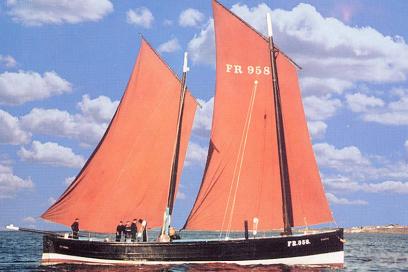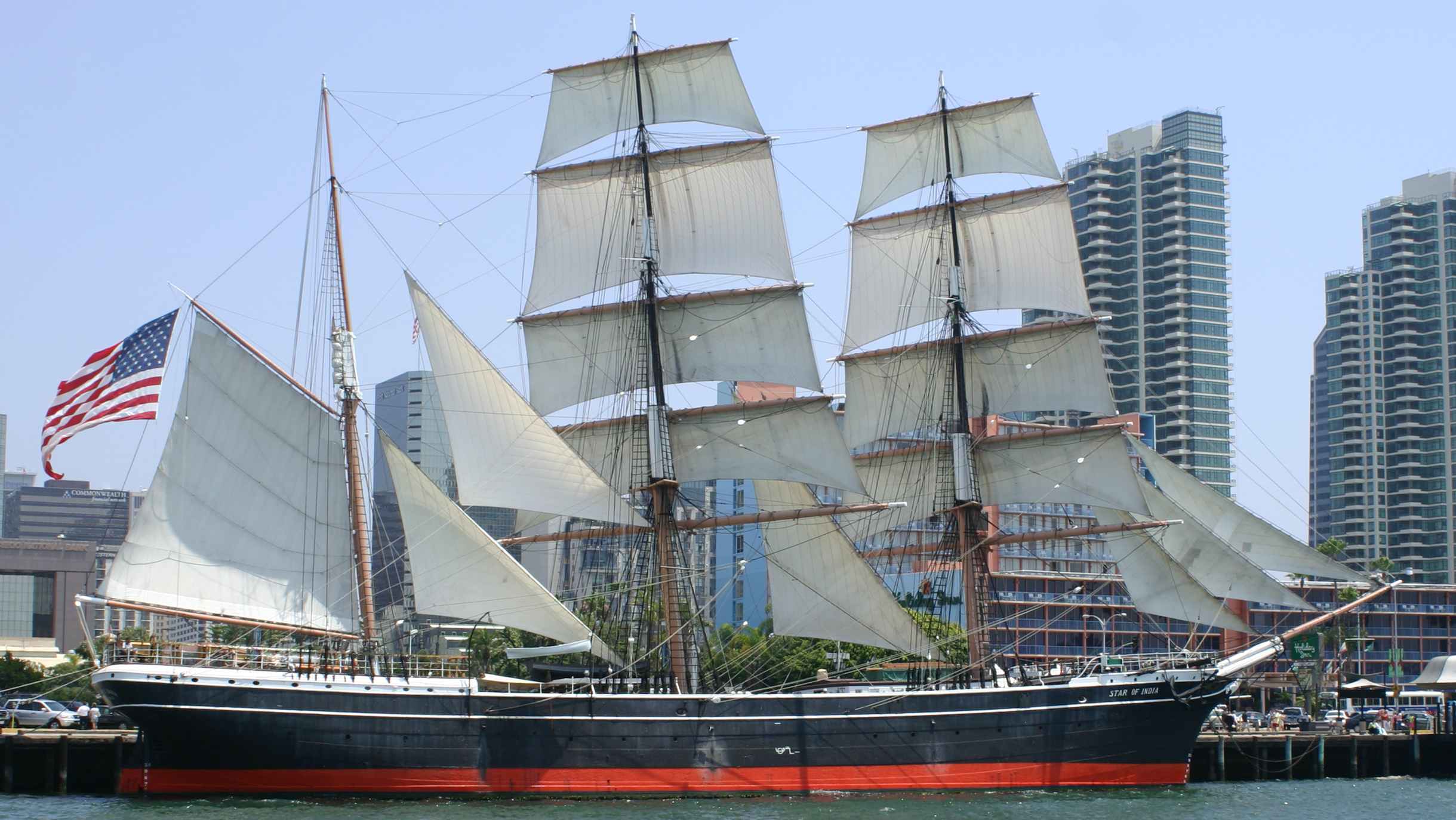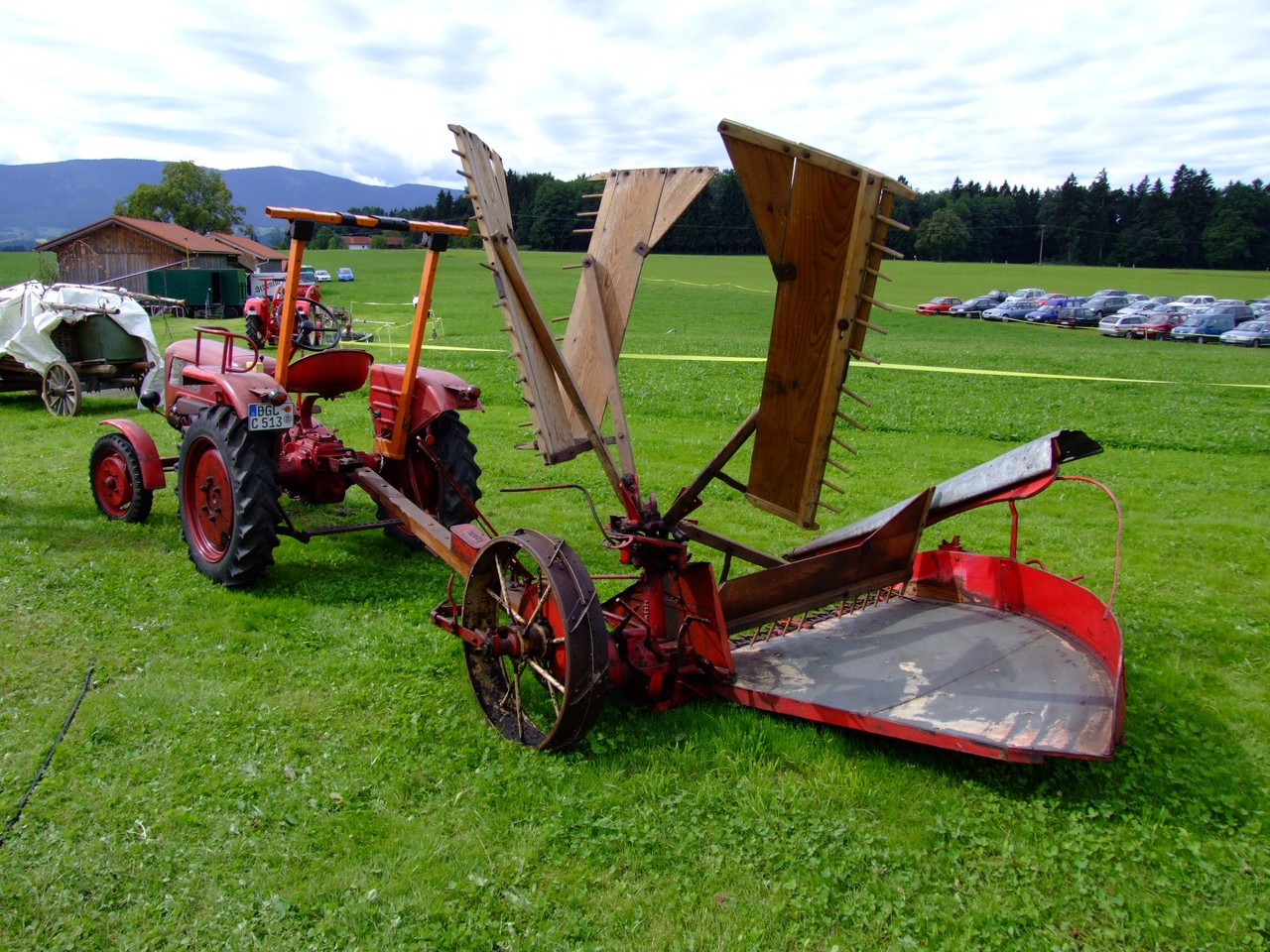|
Lugger
A lugger is a sailing vessel defined by its rig, using the lug sail on all of its one or several masts. They were widely used as working craft, particularly off the coasts of France, England, Ireland and Scotland. Luggers varied extensively in size and design. Many were undecked, open boats, some of which operated from beach landings (such as Hastings or Deal). Others were fully decked craft (typified by the Zulu and many other sailing drifters). Some larger examples might carry lug topsails. Luggers were used extensively for smuggling from the middle of the 18th century onwards; their fast hulls and powerful rigs regularly allowed them to outpace any Revenue vessel in service. The French three-masted luggers also served as privateers and in general trade. As smuggling declined about 1840, the mainmast of British three-masted luggers tended to be discarded, with larger sails being set on the fore and mizzen. This gave more clear space in which to work fishing nets. L ... [...More Info...] [...Related Items...] OR: [Wikipedia] [Google] [Baidu] |
Deal, Kent
Deal is a coastal town in Kent, England, which lies where the North Sea and the English Channel meet, north-east of Dover and south of Ramsgate. It is a former fishing, mining and garrison town whose history is closely linked to the anchorage in the Downs. Close to Deal is Walmer, a possible location for Julius Caesar's first arrival in Britain. Deal became a 'limb port' of the Cinque Ports in 1278 and grew into the busiest port in England; today it is a seaside resort, its quaint streets and houses a reminder of its history along with many ancient buildings and monuments. In 1968, Middle Street was the first conservation area in Kent. The coast of France is approximately from the town and is visible on clear days. The Tudor-era Deal Castle, commissioned by then- King, Henry VIII, has a rose floor plan. History Deal is first mentioned as a village in the Domesday Book of 1086, where it appears as ''Addelam''. It is referred to as ''Dela'' in 1158, and ''Dale'' i ... [...More Info...] [...Related Items...] OR: [Wikipedia] [Google] [Baidu] |
Sail Plan
A sail plan is a description of the specific ways that a sailing craft is rigged. Also, the term "sail plan" is a graphic depiction of the arrangement of the sails for a given sailing craft.> In the English language, ships were usually described, until the end of the eighteenth century, in terms of their type of hull design. Using the type of rig as the main type identifer for a vessel only became common in the nineteenth century. This is illustrated by the terminology for ships in the large fleet of colliers that traded to London from the coal ports of the Northeast of England (of which was a well-known example). Many of these full-rigged ships (square rigged on all of three masts) had the hull type "bark"another common classification was "cat". In the second half of the eighteenth century, the square sails on the mizzen were often eliminated. The resulting rig acquired the name of the hull type: initially as "bark" and soon as "barque". This explains the Royal Navy's descripti ... [...More Info...] [...Related Items...] OR: [Wikipedia] [Google] [Baidu] |
Lug Sail
The lug sail, or lugsail, is a fore-and-aft, four-cornered sail that is suspended from a spar, called a yard. When raised, the sail area overlaps the mast. For "standing lug" rigs, the sail may remain on the same side of the mast on both the port and starboard tacks. For "dipping lug" rigs, the sail is lowered partially or totally to be brought around to the leeward side of the mast in order to optimize the efficiency of the sail on both tacks. The lug sail is evolved from the square sail to improve how close the vessel can sail into the wind. Square sails, on the other hand, are symmetrically mounted in front of the mast and are manually angled to catch the wind on opposite tacks. Since it is difficult to orient square sails fore and aft or to tension their leading edges ( luffs), they are not as efficient upwind, compared with lug sails. The lug rig differs from the gaff rig, also fore-and-aft, whose sail is instead attached at the luff to the mast and is suspended from a s ... [...More Info...] [...Related Items...] OR: [Wikipedia] [Google] [Baidu] |
Mast (sailing)
The mast of a sailing vessel is a tall spar, or arrangement of spars, erected more or less vertically on the centre-line of a ship or boat. Its purposes include carrying sails, spars, and derricks, and giving necessary height to a navigation light, look-out position, signal yard, control position, radio aerial or signal lamp. Large ships have several masts, with the size and configuration depending on the style of ship. Nearly all sailing masts are guyed. Until the mid-19th century, all vessels' masts were made of wood formed from a single or several pieces of timber which typically consisted of the trunk of a conifer tree. From the 16th century, vessels were often built of a size requiring masts taller and thicker than could be made from single tree trunks. On these larger vessels, to achieve the required height, the masts were built from up to four sections (also called masts). From lowest to highest, these were called: lower, top, topgallant, and royal masts. Giving t ... [...More Info...] [...Related Items...] OR: [Wikipedia] [Google] [Baidu] |
Nobby (boat)
The nobby is an inshore sailing boat which was used as a traditional fishing boat around Lancashire and the Isle of Man. The Lancashire nobby originated in Morecambe Bay about 1840 and around Southport. It subsequently came into widespread use down the north west coast of England. The Manx nobby first appeared in the 1880s and was used around the Isle of Man. Many localities on the coast of Great Britain developed their own type of fishing boat adapted to local fishing and sea conditions, and the nobbies are examples of this.March (1969) Lancashire nobby The Lancashire nobby was primarily a shrimp commercial trawler, trawler towing Trawling, beam trawls sized for common "brown shrimp" (''Crangon crangon''), "pink shrimp" or "Aesop prawn" (''Pandalus montagui''), or flatfish. The nobby ranged in size from about for single-handed boats and from for two-man boats. They were all Mast (sailing), pole masted Cutter (ship), cutters with Gaff rig, gaff topsail. In the north west of Eng ... [...More Info...] [...Related Items...] OR: [Wikipedia] [Google] [Baidu] |
Mast (sailing)
The mast of a sailing vessel is a tall spar, or arrangement of spars, erected more or less vertically on the centre-line of a ship or boat. Its purposes include carrying sails, spars, and derricks, and giving necessary height to a navigation light, look-out position, signal yard, control position, radio aerial or signal lamp. Large ships have several masts, with the size and configuration depending on the style of ship. Nearly all sailing masts are guyed. Until the mid-19th century, all vessels' masts were made of wood formed from a single or several pieces of timber which typically consisted of the trunk of a conifer tree. From the 16th century, vessels were often built of a size requiring masts taller and thicker than could be made from single tree trunks. On these larger vessels, to achieve the required height, the masts were built from up to four sections (also called masts). From lowest to highest, these were called: lower, top, topgallant, and royal masts. Giving t ... [...More Info...] [...Related Items...] OR: [Wikipedia] [Google] [Baidu] |
Reaper In Sail
A reaper is a farm implement or person that reaps (cuts and often also gathers) crops at harvest when they are ripe. Usually the crop involved is a cereal grass. The first documented reaping machines were Gallic reapers that were used in Roman times in what would become modern-day France. The Gallic reaper involved a comb which collected the heads, with an operator knocking the grain into a box for later threshing. Most modern mechanical reapers cut grass; most also gather it, either by windrowing or picking it up. Modern machines that not only cut and gather the grass but also thresh its seeds (the grain), winnow the grain, and deliver it to a truck or wagon, called combine harvesters or simply combines, which are the engineering descendants of earlier reapers. Hay is harvested somewhat differently from grain; in modern haymaking, the machine that cuts the grass is called a hay mower or, if integrated with a conditioner, a mower-conditioner. As a manual task, cutting o ... [...More Info...] [...Related Items...] OR: [Wikipedia] [Google] [Baidu] |
Foresail
A foresail is one of a few different types of sail set on the foremost mast (''foremast'') of a sailing vessel: * A fore-and-aft sail set on the foremast of a schooner or similar vessel. * The lowest square sail on the foremast of a full-rigged ship or other vessel which is square-rigged. Sails set forward of the mainmast, such as jibs and staysails, are sometimes referred to as foresails, although " headsails" is a more common term, headsail can also specifically refer to the sail on a forestay that connects directly to the head of the mast. History Foresails set on foremasts between midships and bow were the first type of sail to appear after the mainsail which had been the sole standard rig on sailing vessels for millennia, down to classical antiquity. The earliest foresail, or two-masted ship, has been identified on an Etruscan pyxis from Caere, Italy, dating to the mid-7th century BC: a warship with a furled mainsail is engaging an enemy vessel, deploying a ... [...More Info...] [...Related Items...] OR: [Wikipedia] [Google] [Baidu] |
Cornwall
Cornwall (; kw, Kernow ) is a historic county and ceremonial county in South West England. It is recognised as one of the Celtic nations, and is the homeland of the Cornish people. Cornwall is bordered to the north and west by the Atlantic Ocean, to the south by the English Channel, and to the east by the county of Devon, with the River Tamar forming the border between them. Cornwall forms the westernmost part of the South West Peninsula of the island of Great Britain. The southwesternmost point is Land's End and the southernmost Lizard Point. Cornwall has a population of and an area of . The county has been administered since 2009 by the unitary authority, Cornwall Council. The ceremonial county of Cornwall also includes the Isles of Scilly, which are administered separately. The administrative centre of Cornwall is Truro, its only city. Cornwall was formerly a Brythonic kingdom and subsequently a royal duchy. It is the cultural and ethnic origin of the Cor ... [...More Info...] [...Related Items...] OR: [Wikipedia] [Google] [Baidu] |
The Downs (ship Anchorage)
The Downs is a roadstead (area of sheltered, favourable sea) in the southern North Sea near the English Channel off the east Kent coast, between the North and the South Foreland in southern England. In 1639 the Battle of the Downs took place here, when the Dutch navy destroyed a Spanish fleet which had sought refuge in neutral English waters. From the Elizabethan era onwards, the presence of the Downs helped to make Deal one of the premier ports in England, and in the 19th century, it was equipped with its own telegraph and timeball tower to enable ships to set their marine chronometers. The anchorage has depths down to 12 fathoms (22 m). Even during southerly gales some shelter was afforded, though under this condition wrecks were not infrequent. Storms from any direction could also drive ships onto the shore or onto the sands, which—in spite of providing the sheltered water—were constantly shifting, and not always adequately marked. The Downs served in the age of sail as ... [...More Info...] [...Related Items...] OR: [Wikipedia] [Google] [Baidu] |
Jib Sail
A jib is a triangular sail that sets ahead of the foremast of a sailing vessel. Its tack is fixed to the bowsprit, to the bows, or to the deck between the bowsprit and the foremost mast. Jibs and spinnakers are the two main types of headsails on a modern boat. Modern yachts and small craft Boats may be sailed using a jib alone, but more commonly jibs make a minor direct contribution to propulsion compared to a main sail. Generally, a jib's most crucial function is as an airfoil, increasing performance and overall stability by reducing turbulence on the main sail's leeward side. On boats with only one jib, it is common for the clew of the jib to be abaft the mast, meaning the jib and mainsail overlap. An overlapping jib is called a ''genoa jib'' or simply a genoa (see illustration). These are efficiently used when reaching more broadly than a close reach. Alternatively, a boat may carry smaller jibs, to compensate aerodynamics when the main sail is reefed; these more rugg ... [...More Info...] [...Related Items...] OR: [Wikipedia] [Google] [Baidu] |
Clinker (boat Building)
Clinker built (also known as lapstrake) is a method of boat building where the edges of hull planks overlap each other. Where necessary in larger craft, shorter planks can be joined end to end, creating a longer strake or hull plank. The technique originated in Scandinavia, and was successfully used by the Anglo-Saxons, Frisians, Scandinavians, typically in the vessels known as cogs employed by the Hanseatic League. Carvel construction, where plank edges are butted smoothly, seam to seam, supplanted clinker construction in large vessels as the demand for capacity surpassed the limits of clinker construction. (See Comparison between clinker and carvel below.). Examples of clinker-built boats that are directly descended from those of the early medieval period are seen in the traditional round-bottomed Thames skiffs, and the larger (originally) cargo-carrying Norfolk wherries of England. Etymology From ''clinch'', or ''clench'', a common Germanic word, meaning “to fasten ... [...More Info...] [...Related Items...] OR: [Wikipedia] [Google] [Baidu] |

.jpg)


.jpg)




